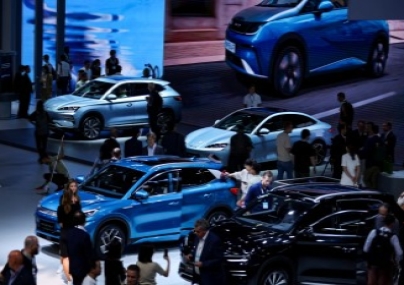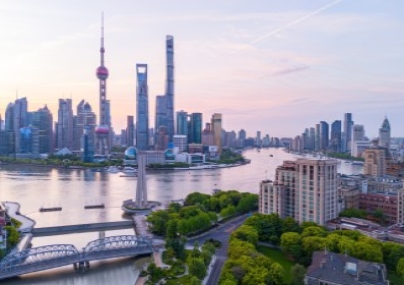
China, already at the centre of world trade, plans to spend billions of dollars to revive intercontinental land routes and develop maritime links to expand commerce and give it more weight in a freight system dominated by European shipping lines.
President Xi Jinping set out his vision during a September 2013 visit to Kazakhstan and earlier this month, announced an initial $40 billion for a "Silk Road fund" to invest in infrastructure and industrial and financial cooperation, aiming to "break the connectivity bottleneck" in Asia.
The modern-day Silk Road starts at Tuanjie Village, the name - meaning "solidarity" - given to a railway station encircled by container depots in Chongqing, a city of 30 million where laptop maker Hewlett Packard and Apple supplier Foxconn have factories, among others.
The first stirrings of this new Silk Road predate Xi's plan: A direct train to Duisburg in Germany left Chongqing in 2011.
A map published by state news agency Xinhua envisages two routes: An overland one snaking through Kazakhstan, Kyrgyzstan and Iran en route to Vienna in Austria; and a maritime route from Chinese ports to Belgium's Antwerp.
Details remain sketchy, but Xinhua said the plan would focus on China's Silk Road Economic Belt and the 21st Century Maritime Silk Road initiative of building roads, railways, ports and airports across Central and South Asia.
"It is China's wish to have an independent route," says Henrik Christensen, president of global logistics at KTZ Express, part of Kazakhstan Railways, which helped develop the Chongqing-Duisburg route.
"The cost of it is so mindblowingly big that I would say the only country in the world that could ever dream of this is China," he says.
One consideration may be the potential for trouble and disruption in the South China Sea, where China is in disputes with several countries over territorial rights.
Another is the fact that the biggest container shipping lines are European, such as A. P. Moller Maersk A/S.
There are more than 240 Chinese shipping firms but they carry only a quarter of the country's trade, the Ministry of Transport said in September, when the government announced tax and regulatory reforms to modernise the sector.
Based on Reuters calculations, state-backed firms have already invested at least $5 billion in transport infrastructure over the past decade along routes that run through Central Asia and weave around Sri Lanka as well as along the Red Sea.
The maritime route links the Chinese ports of Fuzhou and Guangzhou with ports in Indonesia, Sri Lanka, Kenya and Greece.
But some don't see much connection there.
"Of course it's lovely to call it a Maritime Silk Road and talk about a lot of synergies, but in truth, what really are the synergies between these ports?" asks Jonathan Beard, head of ports and logistics at consultancy ICF International.
Back to topLoss-making
Firms such as China Merchants Holdings, China Railway Construction Corp, Cosco Pacific and China Communications Construction Company have built or manage about 10 ports and have offered investment in at least five rail projects in Kyrgyzstan, Kenya and elsewhere.
China's Exim Bank financed 85 percent of the cost of the $361 million first phase of Sri Lanka's Hambantota Port, which was constructed by China Harbour Engineering. A Chinese-Turkish consortium led by China Railway Construction built the $4 billion Ankara-Istanbul high-speed rail line in Turkey.
The train services from Chongqing to Duisburg, and from other Chinese cities such as Chengdu and Wuhan to Europe, are loss-making and subsidised by local governments in China to support demand, according to Chinese rail officials.
But neither cost nor political risks along some of the routes seem to be important for the Chinese firms involved.
China Ocean Shipping Group wants to use its extensive trade network to help increase Chongqing-Duisburg rail volumes, and is ready to launch more shipping routes.
The initiative "is a request from our country," Chairman Ma Zehua said during a shipping conference earlier this month.
"Businesses like ours are, of course, willing to take part in the process to contribute to its development and also benefit from it to advance our businesses," he said.
----------------------------------------------------------------------------------------------------------------------------------
Back to topChina's Silk Road challenges U.S. dominance in Asia
By John Kemp
"The Silk Road, no longer just a concept in history books, has evolved into a story of modern logistics and Sino-European cooperation," Yang Jiechi, China's top diplomat, told a conference this month.
The New Silk Road Economic Belt - from China across Central Asia and Russia to Europe - and the 21st Century Maritime Silk Road - through the Malacca Strait to India, the Middle East and East Africa - have become the centrepiece of China's economic diplomacy.
The belt and the road, as China's diplomats refer to them, were the focus of the Asia-Pacific Economic Cooperation (APEC) summit in Beijing this month. They aim to cement China's emerging role at the heart of the 21st century economy.
China's President Xi Jinping has pledged $40 billion to a new Silk Road fund for investing in infrastructure, resources and industrial and financial cooperation across Asia.
Chinese diplomats have also been busy promoting a new Asian Infrastructure Investment Bank, promising to provide half of its $50 billion start-up capital to help build ports, roads, power projects and other desperately needed infrastructure across the region.
The Silk Road fund and Asia Infrastructure Investment Bank pose a direct challenge to the traditional primacy of U.S.-dominated financial and trade institutions in the region, including the International Monetary Fund, World Bank and Asian Development Bank, all of which were set up following U.S. victory in World War Two.
U.S. diplomats have been manoeuvring furiously to limit the impact of China's economic diplomacy. In the past month, Australia and South Korea both declined to join the new Infrastructure Investment Bank following intense lobbying from officials in Washington, which went all the way up to Secretary of State John Kerry and President Barack Obama himself.
Back to topU.S. leadership challenged
Officially, U.S. diplomats are concerned about governance standards at the new institutions. There are fears about the large share of the voting rights that will go to China and the willingness of the new institutions to lend for projects that do not meet the social and environmental criteria currently employed by multilateral development banks.
Under intense pressure from the United States, the World Bank and Asian Development Bank will no longer finance coal-fired power stations due to concerns about climate change. But many countries, including India, have indicated they intend to continue building coal-fired plants to bring electricity to millions of homes that are currently without secure and affordable access to modern energy.
U.S. officials fear the new Chinese-led institutions will lend to projects that are unable to secure financing from other multilateral institutions, rendering the conditionality ineffective.
But there is a deeper, unspoken fear that the new institutions will be used to enhance China's leadership at the expense of the United States and its traditional allies in Asia including Japan, South Korea and Australia.
In the run-up to the APEC summit, U.S. diplomats have sought to keep the focus on the Trans-Pacific Partnership, a proposed U.S.-led regional trade deal, rather than the broader Free Trade Area of the Asia-Pacific promoted by China.
It is part of a mounting economic, political and military competition between the United States and China across the region.
Back to topBalance of economic power
Asia-Pacific is not the only area where the post-war economic and financial leadership of the United States and its network of allies is being challenged.
The U.S. pivot to Asia is being matched by a similar move on the part of Russia, which has sought to reduce its dependence on the United States and Europe by upgrading its economic ties with China. In the past six months, Russia has signed two major deals to supply natural gas to China, which has become Russia's most important trading partner.
In July 2014, China, Russia, India and Brazil reached agreement on a $100 billion New Development Bank to be headquartered in Shanghai. China and Russia have also been busy promoting economic and military ties across Central Asia through the Shanghai Cooperation Organisation.
The major financial and economic institutions, which experts sometimes call the "international financial architecture," no longer correspond to the balance of power and the shifting centre of gravity in the world economy.
The International Monetary Fund, World Bank and regional development banks are all dominated by the United States and its allies in terms of voting rights, capital structure, headquarters location and staffing.
Efforts to reform them to give a greater role to China and the other fast-growing developing economies have proved largely unfruitful.
The multilateral lending institutions are severely undercapitalised and have nowhere near enough resources to meet the enormous infrastructure needs across Asia, Africa and Latin America.
The result is that many multilateral institutions appear to be outdated, too small and entrenched in colonialist approaches to development.
Back to topTrade and financial flows
There is still an assumption that economies of developing countries are defined by their relationship with their more developed counterparts. But that world has vanished over the last decade.
More than half the exports from developing economies were sent to other developing economies in 2013, according to the World Trade Organization ("International Trade Statistics 2014").
Countries in Asia sent more than 60 percent of their exports to other nations in Asia and to Africa and the Middle East, compared with just over 15 percent each to North America and Europe.
As the world's greatest export powerhouse, China has accumulated vast foreign exchange reserves and is now becoming a major supplier of capital.
Prior to the financial crisis, that capital was tied up passively and uselessly in U.S. Treasury bonds. Now, China wants to use its capital more productively to invest in infrastructure in its major trading partners and at the same time, buy more economic and political influence.
There is nothing new in the idea that countries seek to turn financial capital into political power. Britain pursued the same approach in the 19th century, and the United States has done so successfully since World War Two.
Market access and capital can all be traded for various forms of influence. The Marshall Plan traded U.S. economic assistance in European reconstruction for a pro-American orientation in European foreign policy.
As the balance of power within the global economy shifts, it is inevitable that the international economic architecture will have to evolve.
Some Western foreign policy specialists have naively assumed that emerging markets would become integrated into existing post-war, West-dominated structures of power and governance.
But it was always at least as likely that those institutions would have to adapt and change to accommodate the rising economic and financial power of emerging markets.
Just as access to American markets and capital was once a key component of U.S. diplomacy, China is now employing its financial and trade muscle to win friends and influence.
Back to top


